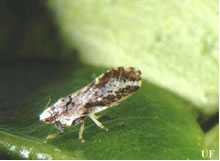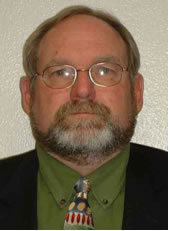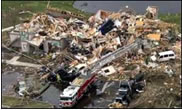
Vol. 3, No. 2, February 2007 |
 Printer-Friendly PDF Version Printer-Friendly PDF Version |
New ESF 17 Coordinator
|
Mr. Joe Kight is Florida’s new Emergency Support Function (ESF) 17 Coordinator reporting to Dr. Thomas Holt, State Veterinarian and Director of the Division of Animal Industry (DAI). | |||
Volusia Farm Service Agency Relocates Due to Tornado Damage
Agricultural producers participating in USDA programs served by the Deland/Volusia County USDA Service Center should contact the Tavares/Lake County USDA Service Center (for information and directions call (352) 343-2581) to process any program applications for the Farm Service Agency (FSA). | |||
[top]
New Training Unit: Introducing Florida’s Livestock and Horse Industries
If there is a problem understanding Florida’s diverse and growing animal agricultural sectors, it is determining what should be included. Cattle, pigs and horses, certainly. And probably rabbits and chickens. But what about honeybees and exotic big game animals such as Axis deer on game preserves or unusual snakes and tarantulas imported legally and sold to exotic pet enthusiasts?
This training unit presents an overview of the livestock and horse industries in Florida and gives a snapshot of their distribution, value to the economy and viability.
http://www.flsart.org/library/index.htm

Florida has a large and vital industry in every sector of livestock and horses, from raising cattle, pigs and chickens to horse racing.
New Training Unit On Line: Foreign Animal Disease Recognition
In an effort to promote farm security in Florida, a 70-minute training unit “Livestock & Horses: Foreign Animal Disease Recognition?is now on line at the SART web site: www.flsart.org/PDF/LAH-FAD-LP-2007-01.pdf.
Christian Hofer, Katherine Maldonado, Paul Gibbs, Charles Brown and Carol Lehtola, all of the University of Florida, Gainesville, introduce foreign animal diseases, discuss nine threats to animal agricultural security and addresses methods of increasing farm security.
It is vitally important to be alert to foreign animal diseases because recognition results in quarantines, interruption of the food supply chain, the slaughter of thousands of animals, millions of dollars spent on controls and, ultimately, increased cost to the consumer.
Produced by professionals at the College of Veterinary Medicine and the Department of Agricultural and Biological Engineering, IFAS, the new training unit “Livestock & Horses: Foreign Animal Disease Recognition?is a 70-minute primer in the potential for exotic animal disease vectors to impact Florida’s animal industry. 
New Training Unit Explores Exotic Plant Diseases

Citrus greening has arrived in Florida and probably cannot be eradicated.
Under the heading Three Exotic Plant Diseases Threatening Florida, a new SART training unit discuss three specific agricultural sectors ?citrus, field crops and nurseries ?and the three diseases that pose the greatest threat to their survival. It also illustrates the variety of ways that diseases can reach and become entrenched in Florida.
Citrus, an enormous agricultural sector in the Sunshine State (90,000 jobs and an output impacts of $10 billion), is threatened with extremely dire consequences as a result of “citrus greening.?Although Vietnamese scientists recently reported a breakthrough, there is no known cure for this disease, which quickly kills trees and renders fruit unpalatable.
Although the Florida soybean crop is small, it ?as other state crops throughout the south ?struggles with “soybean rust.?Disease spores were probably blown into Florida from South America by a hurricane in the ?0s!
The nursery industry faces “sudden oak death,?syndromes not limited to oak trees. Although this disease is not quickly fatal for yard, garden and nursery plants it quickly begins to deform stems, defoliate branches and wither leaves and fruit. SOD was probably imported from wholesale nurseries in California.

Three exotic psyllid species have been found in Florida and all carry a bacteria detrimental to the citrus industry.
New Training Unit: An Entomological Perspective for Emergency Agricultural Response

Plant-eating snails are not native to the Florida environment and pose a danger because they have no natural native predators; they are not part of the natural food-chain of the state.
The final unit ?for now ?in the SART series of training modules and units is An Entomological Perspective for Emergency Agricultural Response. Its Lesson Plan, Participant Workbook and PowerPoint Presentation focus on Florida as a “sentinel state.?Our peninsula’s unique geographic position attracts wandering entomological species (bugs) from every corner of the earth ?so far, nothing identified from space, no extraterrestrial seeding of soybean fields ?and, by and large, the overwhelming majority are Not Beneficial!
An Entomological Perspective unit examines some of the invasive insects loose in the state, and the measures for responding effectively in a demographic climate of rapid urbanization: management, eradication or a combination of the two strategies. Also reviewed are some of the bugs that Florida farmers, ranchers and growers DO NOT want here regardless of the cost!
Guest Appearances May Not Highlight SART Events
There May Be A Test ?
Quick! Exotic Update: Air PotatoOne potato, two potato ?billion potato! About the SART SentinelEditor: Rick Sapp, PhD, Technical Writer, Florida Department of Agriculture & Consumer Services, Division of Animal Industry [rsa5@cox.net] |
|||||||||






